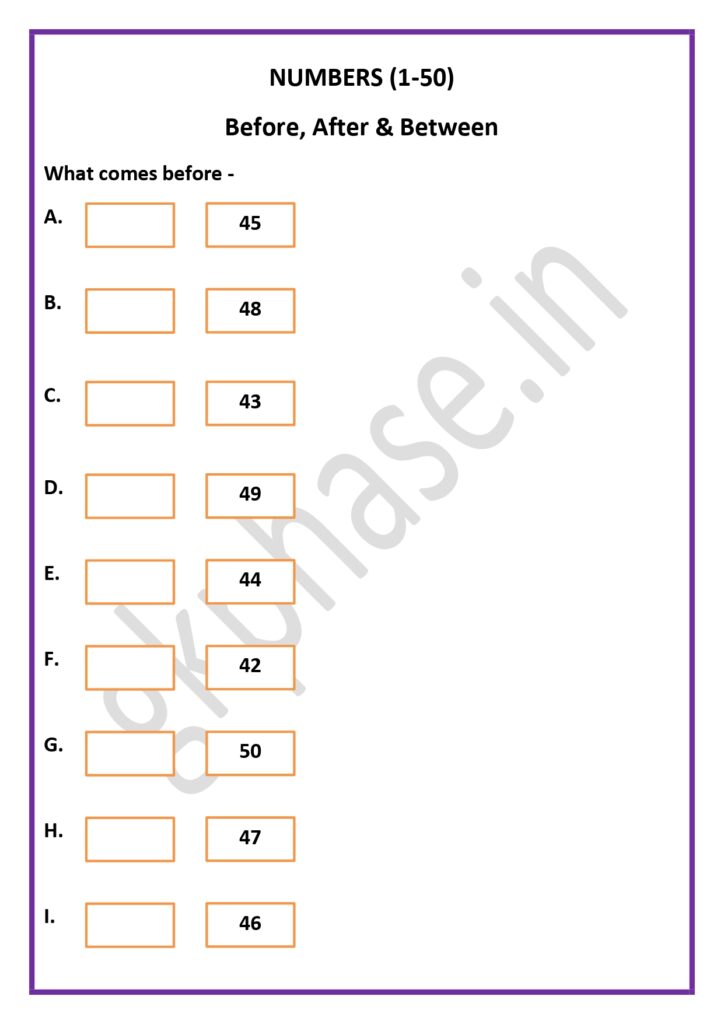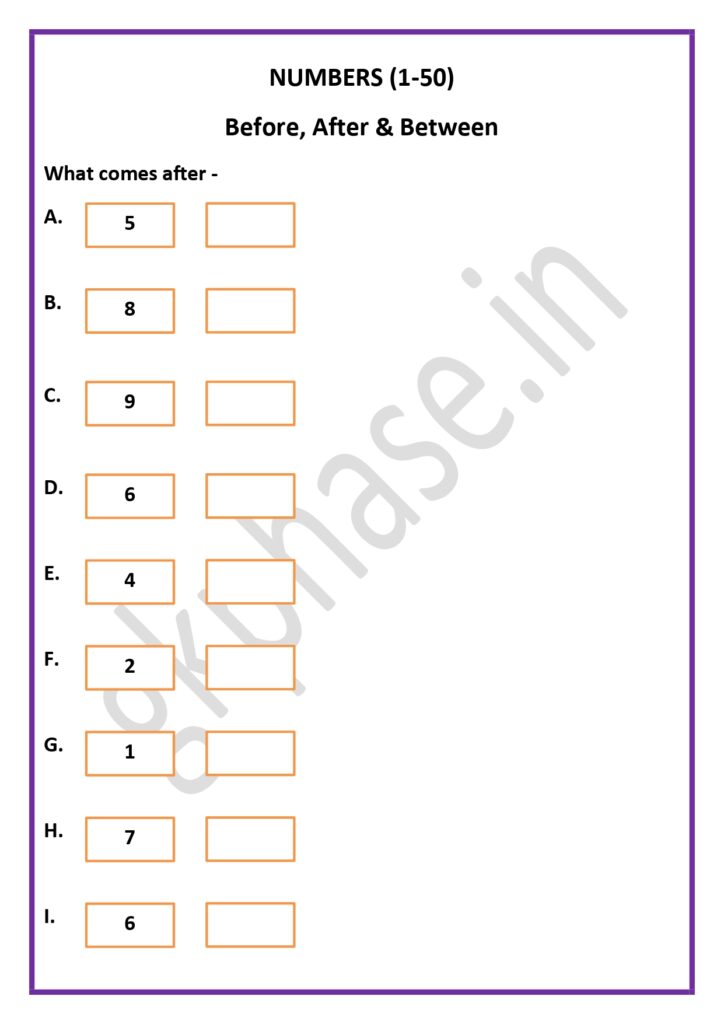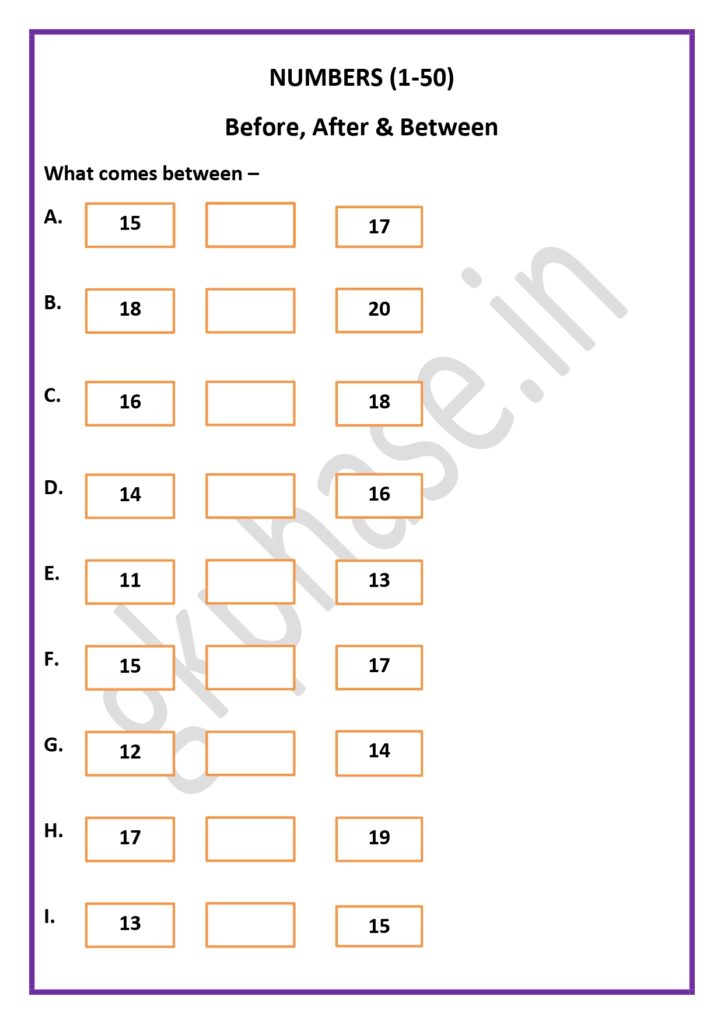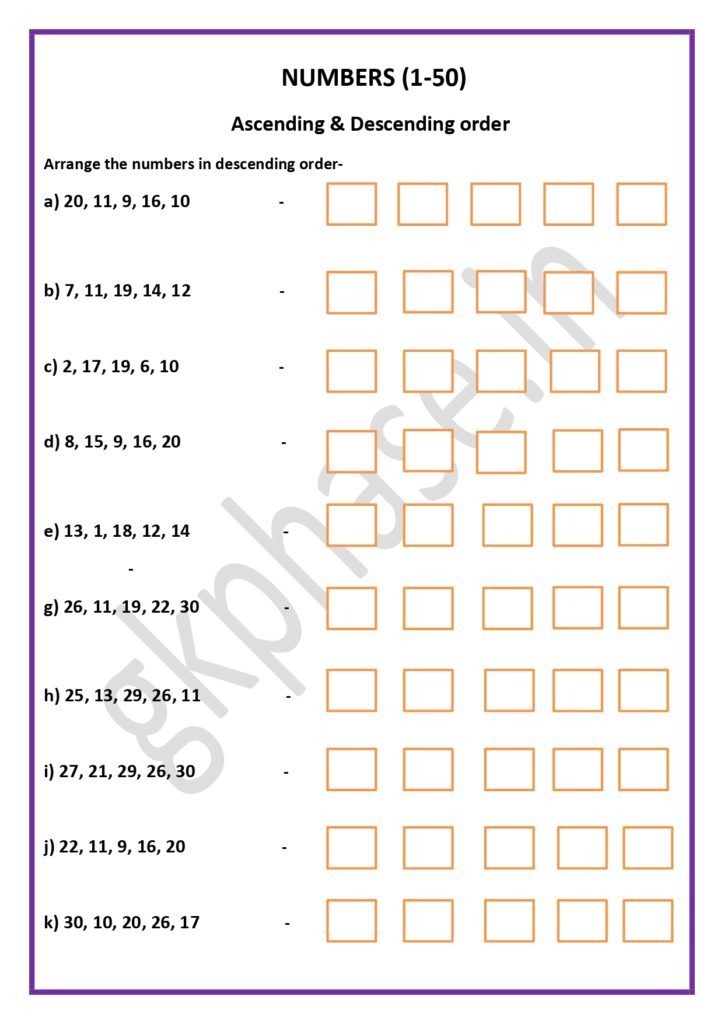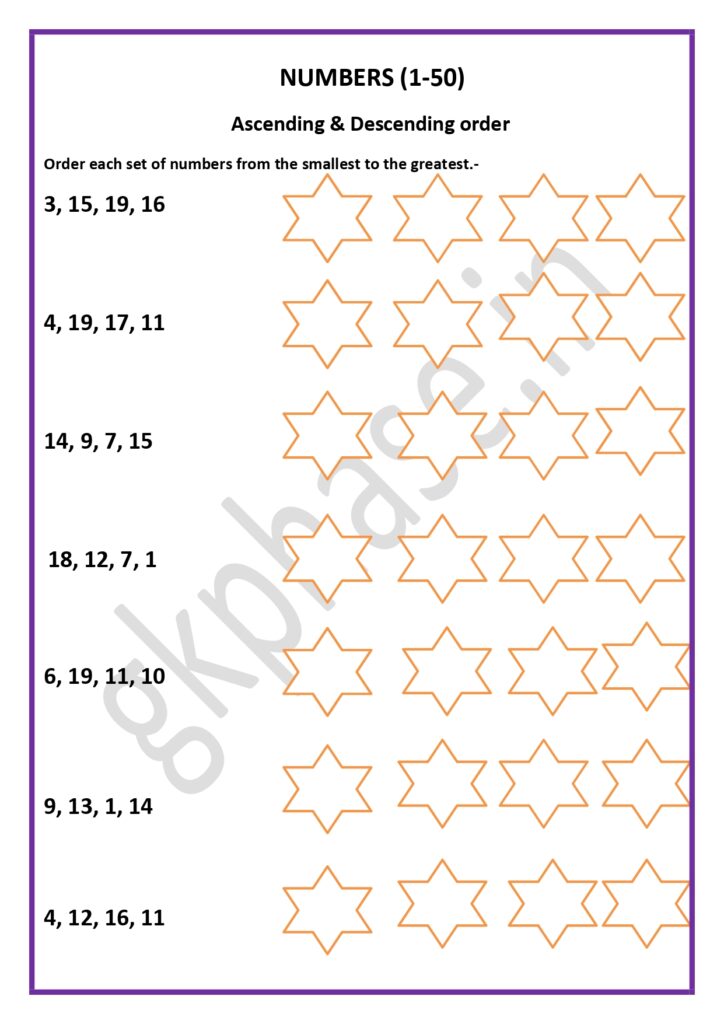Numbers 1-50
Place value
What is Place Value?
Place value tells us the value of each digit in a number based on its position.
Example with Number 10
When we look at the number 10, we have two digits: 1 and 0.
The 1 is in the tens place.
The 0 is in the ones place.
So, in 10:
The 1 in the tens place means 1 group of ten.
The 0 in the ones place means 0 ones.
This means:
10 = 1 ten and 0 ones.
Let’s draw it:
10: [1 group of 10 sticks]
Here is a simple diagram:
| | | | | | | | | | (10 sticks in a bundle)
Example with Number 23
Now, let’s look at the number 23:
The 2 is in the tens place.
The 3 is in the ones place.
So, in 23:
The 2 in the tens place means 2 groups of ten.
The 3 in the ones place means 3 ones.
This means:
23 = 2 tens and 3 ones.
Let’s draw it:
23: [2 groups of 10 sticks] and [3 single sticks]
Here is a simple diagram:
| | | | | | | | | | (10 sticks in a bundle)
| | | | | | | | | | (another 10 sticks in a bundle)
| | | (3 single sticks)
Comparing Numbers
Let’s say we have two numbers: 5 and 3.
To compare these numbers, we can use the symbols “<” (less than), “>” (greater than), or “=” (equal to).
– If we look at the number 5 and the number 3, we see that 5 is bigger than 3. So, we can say “5 is greater than 3,” and we write it as 5 > 3.
– Alternatively, we can say “3 is less than 5,” and we write it as 3 < 5.
We can also compare if the numbers are equal:
– In this case, 5 is not equal to 3, so we write it as 5 ≠ 3 (5 is not equal to 3).
So, in simple terms:
– 5 is greater than 3 (5 > 3).
– 3 is less than 5 (3 < 5).
– 5 is not equal to 3 (5 ≠ 3).
Before, After and Between
1. Before:
“Before” means something that comes earlier or is in front of something else in a sequence. For example, if we have the numbers 1, 2, 3, 4, and 5, then:
– 2 comes before 3.
– 4 comes before 5.
– 1 comes before 2.
Example: If you have a line of toys arranged from left to right like this: Teddy Bear, Doll, Train, Car. If you were asked, “What comes before the Train?” You would answer, “The Doll comes before the Train.”
2. After:
“After” means something that comes later or is behind something else in a sequence. Using the same sequence of numbers:
– 3 comes after 2.
– 5 comes after 4.
– 2 comes after 1.
Example: If you have a line of fruits arranged from left to right like this: Apple, Banana, Orange, Pear. If you were asked, “What comes after the Banana?” You would answer, “The Orange comes after the Banana.”
3. Between:
“Between” means something that is in the middle of two other things. For example:
– Between 2 and 4, we have 3.
– Between Monday and Wednesday, we have Tuesday.
Example: If you have a line of flowers arranged from left to right like this: Rose, Daisy, Tulip, Lily. If you were asked, “What flower is between the Rose and the Tulip?” You would answer, “The Daisy is between the Rose and the Tulip.”
These concepts help children understand the order and arrangement of things, whether they’re numbers, objects, or days of the week.
Counting in tens
Counting by tens means that instead of counting one by one, we count by groups of ten. It’s like taking big steps instead of small ones.
Here’s an example:
Imagine we have a bunch of apples, and we want to count them. Instead of counting each apple one by one, we can group them into groups of ten.
Let’s say we have 30 apples.
1. First, we count the apples by tens: 10, 20, 30. We’ve counted three groups of ten apples each.
2. Then, we can count the remaining apples if there are any. In this case, we don’t have any remaining apples because we counted them all in groups of ten.
So, instead of counting each apple individually, we counted them in groups of ten, which makes it quicker and easier.
Another example:
Let’s count from 10 to 50 by tens:
10, 20, 30, 40, 50.
We’re counting by tens, so we’re skipping all the numbers in between and just focusing on the groups of ten.
Number Names
Number names are the words we use to talk about numbers. For example, the number “1” is called “one,” the number “2” is called “two,” and
Number Names from 1 to 50
Here are the number names:
1. 1- One
2. 2 – Two
3. 3 – Three
4. 4 – Four
5. 5 – Five
6. 6 – Six
7. 7 – Seven
8. 8 – Eight
9. 9 – Nine
10. 10 – Ten
11. 11 – Eleven
12. 12 – Twelve
13. 13 – Thirteen
14. 14 – Fourteen
15. 15 – Fifteen
16. 16 – Sixteen
17. 17 – Seventeen
18. 18 – Eighteen
19. 19 – Nineteen
20. 20 – Twenty
21. 21 – Twenty-one
22. 22 – Twenty-two
23. 23 – Twenty-three
24. 24 – Twenty-four
25. 25 – Twenty-five
26. 26 – Twenty-six
27. 27 – Twenty-seven
28. 28 – Twenty-eight
29. 29 – Twenty-nine
30. 30- Thirty
31. 31 – Thirty-one
32. 32 – Thirty-two
33. 33 – Thirty-three
34. 34 – Thirty-four
35. 35 – Thirty-five
36. 36 – Thirty-six
37. 37 – Thirty-seven
38. 38 – Thirty-eight
39. 39 – Thirty-nine
40. 40 – Forty
41. 41 – Forty-one
42. 42 – Forty-two
43. 43 – Forty-three
44. 44 – Forty-four
45. 45 – Forty-five
46. 46- Forty-six
47. 47 – Forty-seven
48. 48 – Forty-eight
49. 49 – Forty-nine
50. 50- Fifty
Biggest and Smallest
Imagine we have a set of numbers, like 3, 7, 2, 5, and 9. We want to find out which number is the biggest (largest) and which number is the smallest (tiniest).
1. Biggest Number:
The biggest number is the one that is the greatest or largest among all the numbers. To find the biggest number, we look for the number that is the highest.
Example: If we have the numbers 3, 7, 2, 5, and 9, we can see that 9 is the biggest because it’s the largest number.
2. Smallest Number:
The smallest number is the one that is the least or tiniest among all the numbers. To find the smallest number, we look for the number that is the lowest.
Example: In the same set of numbers (3, 7, 2, 5, and 9), we can see that 2 is the smallest because it’s the tiniest number.
Ascending and Descending order
1. Ascending Order:
“Ascending order” means arranging things from the smallest to the largest. It’s like climbing up a staircase, where each step is higher than the previous one.
Example: If we have a set of numbers like 3, 1, 5, 2, and 4, arranging them in ascending order means putting them from smallest to largest. So, in ascending order, the numbers would be: 1, 2, 3, 4, 5.
Imagine you’re climbing stairs, starting from the lowest step (1) and moving up to the highest step (5).
2. Descending Order:
“Descending order” means arranging things from the largest to the smallest. It’s like going down a staircase, where each step is lower than the previous one.
Example: Using the same set of numbers (3, 1, 5, 2, 4), arranging them in descending order means putting them from largest to smallest. So, in descending order, the numbers would be: 5, 4, 3, 2, 1.
Imagine you’re descending stairs, starting from the highest step (5) and moving down to the lowest step (1).
Welcome to gkphase
To download free printable activities and worksheet of Numbers (1-50) (class 1st maths) in PDF form














